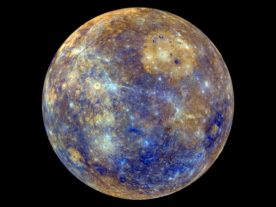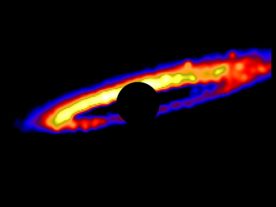
Study: Pluto Should Be a Planet!
In 2006, members of the International Astronomical Union or the IAU, an organization recognized as the authority for naming celestial bodies, voted on a set of characteristics that define what makes a planet a planet. One of those traits required a planet had to “clear” its orbit; meaning it had to provide the greatest gravitational force in […]

Astronomers Discover A Dozen New Jovian Moons
As a team of astronomers was looking beyond Pluto for the mysterious Planet 9. So far they haven’t located the giant hypothetical planet, but they did wind up discovering a dozen new moons orbiting Jupiter. “Jupiter just happened to be in the sky near the search fields where we were looking for extremely distant Solar System […]

First Detection of Helium in an Exoplanet Atmosphere
Scientists say for the first several hundred thousand years or so after the Big Bang, there were virtually only two elements in the universe, hydrogen, and helium. A hydrogen atom is made of only one proton and one electron, and a helium atom has two each of protons, electrons, and neutrons. Hydrogen and then helium are […]

Newly Discovered Exoplanet Resembles Planet Mercury
A newly found exoplanet called K2-229b is about 20% larger and 2.5 times more massive than Earth. But the international team of astronomers, who recently discovered it, say it’s more like a super-charged version of our solar-system’s innermost planet, Mercury. They describe the planet as hot, metallic, made of iron and nickel, circles an orange K-dwarf […]

Insight Into Planetary Evolution – Dark Matter Rare in Old Galaxies
Scientists Gain New Insight into Planetary Evolution Scientists recently gained new insight into the evolution of planet formation by creating and studying a model of a fairly young solar system 300 light years from Earth. The nearly 13 million year-old planetary system circles a star known as HD 106906. The system features a surrounding planet […]
Is the Universe Connected By a Cosmic Web?
Some people think that the universe is just a hodge-podge of various celestial objects, such as planets, stars and galaxies. But over the years, scientists have found more evidence that the universe may be anything but random, and is actually more organized and interconnected—like an enormous spider web. Our place in the web Let’s start […]
Biggest Wave Spotted; Walking Heel-to-Toe; Newborn Exoplanets
New Record for Biggest Wave Measured by Buoy The UN’s World Meteorological Society says the biggest wave ever to be measured by a buoy was identified at 0600 universal time on February 4, 2013. The colossal 19-meter swell was spotted in the North Atlantic Ocean between Iceland and the UK. The previous highest wave recorded […]
Did our Sun Snatch Planet 9 from Another Solar System?
Is it possible that the new-found theoretical Planet 9 is actually an exoplanet, a planet from another solar system? According to astronomers at Sweden’s Lund University, it’s “highly likely” that Planet 9 was actually “snatched” from another solar system by our young sun some 4.5 billion years ago, or within 100 million years after its formation. […]
Scientists Find Traces of Early Earth in Volcanic Rock
According to most scientists, Earth was formed between 4.5 and 4.6 billion years ago after gravity forced gas and dust left over from the creation of the Sun accreted into an object called a planetesimal. Over time, the planetesimal continued to gather more and more material and eventually became a planet. Scientists say heat produced […]

Dwarf Planet Moon Discovered; Supplements Boost Antidepressants; Kepler Back in Business
Hubble Spots Moon Circling Distant Dwarf Planet Out in the far reaches of our solar system lies the Kuiper Belt. This region of space is occupied by icy objects left over from the creation of the solar system. Several dwarf planets, such as Pluto, also occupy the Kuiper Belt. Astronomers studying images gathered by the […]
